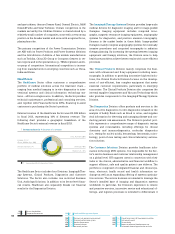Siemens 2013 Annual Report Download - page 169
Download and view the complete annual report
Please find page 169 of the 2013 Siemens annual report below. You can navigate through the pages in the report by either clicking on the pages listed below, or by using the keyword search tool below to find specific information within the annual report.
253 D. Consolidated Financial Statements
357 E. Additional Information
245 C. Compensation Report, Corporate Governance
statement pursuant to Section a of the
German Commercial Code, Takeover-relevant
information and explanatory report
246 C. Siemens AG ( Discussion on basis of
German Commercial Code)
250 C. Notes and forward-looking statements
added gas turbines to replace aging infrastructure and take ad-
vantage of the country ’s ongoing natural gas boom. Fossil
markets in the Asia, Australia region remained strong, with a
number of nations adding capacity. These included China and
India for coal-fired power generation and South Korea for gas-
fired power plants.
In the markets served by our Wind Power Division, growth
came from new offshore wind projects. Also onshore wind
markets returned to a moderate growth path compared to
fiscal , except in the U.S. where concerns about potential
expiration of tax incentives had led to a market boom due to
project pre-drawings in .
The markets served by our Oil & Gas Division rose on increased
investment demand for exploration and production of oil and
gas. On a geographic basis, market growth for the Division’s
compression and oil and gas solutions business came mainly
from the U.S., the Middle East, Africa, Russia, and Brazil. Growth
in the Division’s industrial power markets was led by Asia, the
Middle East, and parts of Europe. While market for small steam
turbines remained on previous year’s level, demand was stron-
ger for small-scale combined-cycle power plants.
The markets served by our Power Transmission Division re-
covered from weakness a year earlier. While markets grew
slightly in most regions, year-over-year, growth was strongest
in North-East Asia, the Middle East, Africa and the Americas.
In emerging countries, growth was driven mainly by expan-
sion of infrastructure. In industrialized economies, customers
mainly replaced and modernized equipment and also integrat-
ed renewable sources into their transmission grids. Despite
the larger pattern of global growth, power transmission mar-
kets also suffered from overcapacities in certain segments,
especially power transformers.
In fiscal , markets addressed by our Healthcare Sector
grew moderately year-over-year. Growth was clearly driven by
emerging markets, as these countries continue to expand
access to healthcare for a broader population and build up
their healthcare infrastructure. In contrast, markets in indus-
trialized countries grew only modestly compared to the prior
fiscal year as demand was held back by healthcare reforms and
budgetary constraints, particularly in Europe. Healthcare IT
markets grew faster than the healthcare market as a whole,
on particular strength in the U.S. On a geographic basis, mar-
kets in Asia, Australia grew in the high single digits, including
double-digit growth rates in China. Markets in the Americas
including the U.S. grew moderately. Growth in the U.S. was
supported by strong demand for healthcare IT solutions driven
by the HITECH Act and the relevant portions of the Affordable
Care Act. In contrast, markets in Europe, C.I.S., Africa, Middle
East declined slightly. In Europe, markets experienced a further
decline in spending for healthcare in southern and western
European countries, which continued to suffer from the sover-
eign debt crisis.
The overall market for our Industry Sector as well as for the
Divisions Industry Automation and the Drive Technologies de-
clined in fiscal . While the pharmaceutical, chemical, auto-
motive and food and beverage markets grew slightly compared
to the prior fiscal year, this growth was more than offset by
declines in other markets including particularly machine build-
ing and Industry ’s markets for solutions and products for wind
power. On a regional basis, markets in Asia, Australia and the
Americas did not offer growth opportunities year-over-year,
while markets in Europe declined, particularly in Southwest
Europe. Within the Asia, Australia region, growth accelerated
somewhat in China in the second half of fiscal following a
weak development in the first half of the fiscal year. Within the
Americas, market development in the U.S. was supported by
lower energy prices due largely to a greater supply of energy
produced in the U.S., primarily natural gas. But momentum
declined somewhat during the fiscal year.
Within the markets served by our Industry Automation Divi-
sion, short-cycle manufacturing industries saw de-stocking by
customers which held back market development. Industrial IT
markets grew moderately, but slightly below their expected
long-term average growth rate.
Markets served by our Drive Technologies Division also saw
de-stocking effects within short-cycle industries. Markets for
industrial infrastructure industries, including the Division’s
markets for solutions and products for wind power and rail
markets, declined or showed no growth momentum. Markets
for long-cycle industries such as mining and oil and gas grew
only slightly year-over-year, or even declined. In some indus-
tries customers delayed or postponed large infrastructure
projects.
























